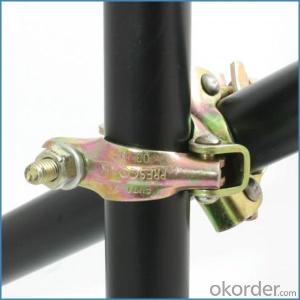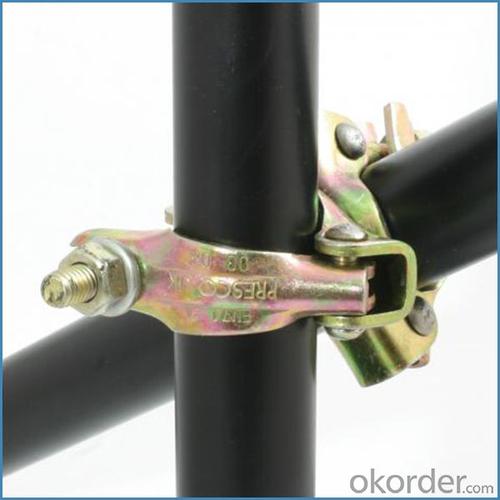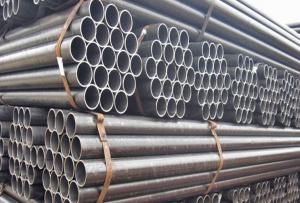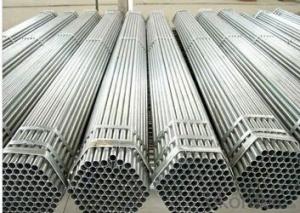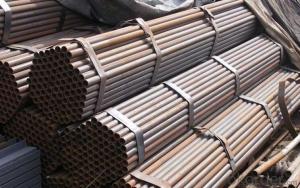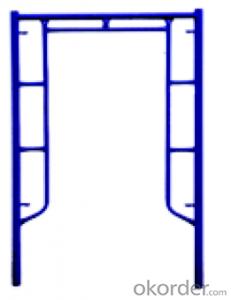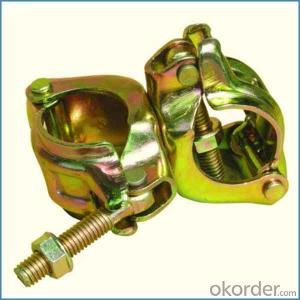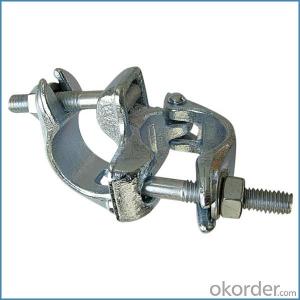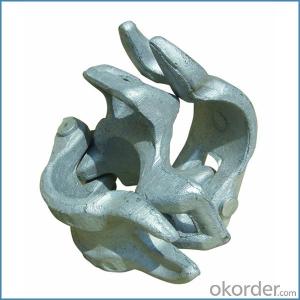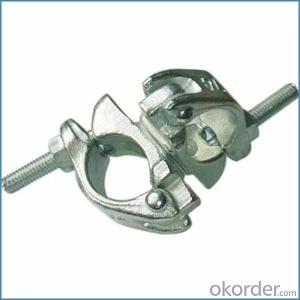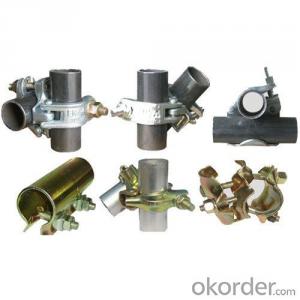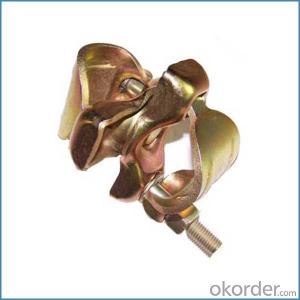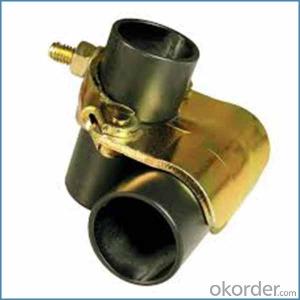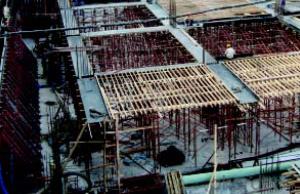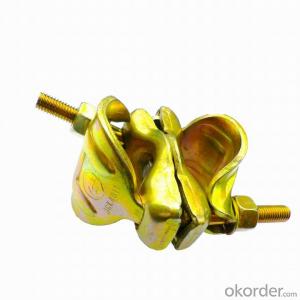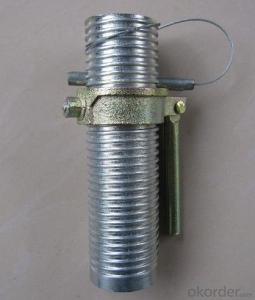Pressed Scaffold Clamp british German Forged Type
- Loading Port:
- Tianjin
- Payment Terms:
- TT OR LC
- Min Order Qty:
- 1000 kg
- Supply Capability:
- 100000 kg/month
OKorder Service Pledge
OKorder Financial Service
You Might Also Like
Pressed Scaffold Clamp british German Forged Type
Description
1.The scaffolding coupler is always used to connect the steel pipe as scaffolding system.
2.The often used coupler is swivel coupler and righ angle coupler .
3.We can provide types of scaffolding coupler according to your requirement.
4.Couoler can fix the 48.3mm scaffolding steel pipe tightly and make the whole scaffolding system more steadily.
Feature
(1)Excellent Anti-Breaking—Cold Pressed Steel
(2)Outstanding Resistance Deformation
(3)Strong Anti-Dropping Ability
Photo
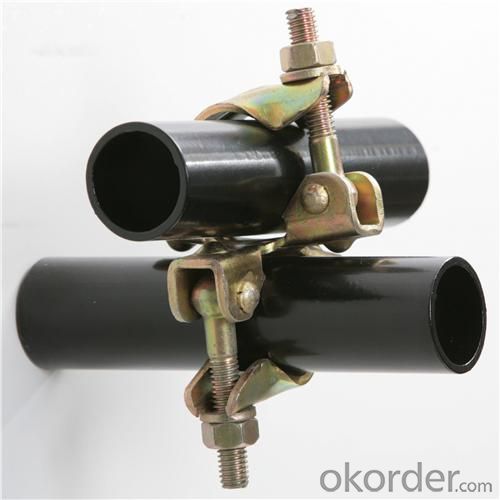
Parameter
| Material | Q235,345steel |
| Size | 48.3mm*48.3mm |
| Surface finish | Galvanized |
| Weight | 1.1kg around |
| Standard | BS1139,EN74 |
| Package | 25pcs/bag,steel pallet |
| Manufacture | As per customer requirement |
| Market | Africa, South America, the Middle East and Asia |
FAQ
Q: Are you a factory or trading company?
We are a state-owned corporation in China,dealing with various kinds of building materials.We have our holding subsidiaries.
Q: Where is your factory located? How can I visit there?
Our factory is located all around China.
Q: Can I get some samples?
Sample is free, customer only pay freight for the first time.
Q: Delivery?
10-30days. (5-15 containers)
Any question,feel free to contact us.
- Q: How do steel tube couplers contribute to the overall speed of a scaffolding project?
- The overall speed of a scaffolding project is enhanced by steel tube couplers in various ways. To begin with, they offer a rapid and effective method of connecting steel tubes together, eliminating the need for time-consuming welding or threading. This enables the scaffold structure to be assembled and disassembled quickly, saving valuable time on the project. In addition, steel tube couplers are specifically designed to establish a secure and stable connection between tubes, ensuring the structural soundness of the scaffolding. This eliminates the necessity for additional time-consuming reinforcement or bracing, as the couplers provide the essential strength and stability to support the scaffold. Moreover, the versatility of steel tube couplers permits easy adjustment and modification of the scaffold structure. Couplers can be effortlessly repositioned or replaced as required, allowing for swift alterations to the scaffold design. This flexibility helps to streamline the construction process and accommodate any changes or modifications that may arise during the project. Overall, the utilization of steel tube couplers in scaffolding projects significantly contributes to the speed and efficiency of the construction process. Their quick and secure connections, as well as their versatility and adaptability, aid in saving time and resources, enabling the project to be completed promptly.
- Q: Are steel tube couplers suitable for supporting platforms or decking on scaffolding?
- Steel tube couplers are a great option for supporting platforms or decking on scaffolding. Designed to securely connect steel tubes, they offer a strong and reliable connection. These couplers are frequently used in scaffolding systems to create a stable platform for workers to reach higher areas. Not only are they durable and capable of handling heavy loads, but they are also easy to install and can be adjusted to different angles and positions. This flexibility allows for various scaffolding designs. In summary, steel tube couplers are a reliable and efficient choice for supporting platforms or decking on scaffolding.
- Q: what does the terminology 'Scaffolding principle' mean, refering to psychology?
- the christians were at the forefront of the anti-slavery movement in this country. St. Patrick was almost single handedly responsible for eliminating slavery in Ireland in the 400s. Genocide is not a Christian principle. Self-defense is. The church did NOT run the cavalry, by the way. Immigration *legally* is allowed by all countries and the Europeans legally immigrated to North America and were accepted by the inhabitants. Invasion is a very strong and biased word.
- Q: What are the common reasons for failure or malfunction of steel tube couplers?
- Steel tube couplers can fail or malfunction for various reasons. One primary cause is improper installation, which occurs when the coupler is not aligned and tightened correctly. This can result in misalignment or slippage, leading to joint failure. To ensure a secure connection, it is crucial to follow the manufacturer's guidelines and use the appropriate tools. Corrosion is another common factor that contributes to coupler failure. Steel tube couplers are frequently exposed to moisture, chemicals, and extreme temperatures, causing corrosion over time. This weakens the coupler and compromises its structural integrity, eventually resulting in failure. Failure to adequately maintain or neglect the couplers can also contribute to their failure. Regular inspections, cleaning, and lubrication are necessary to prevent the accumulation of dirt, debris, or rust that can hinder proper functioning. Neglecting maintenance accelerates deterioration and increases the risk of malfunction. Exceeding the load capacity is a significant cause of coupler failure. When subjected to excessive loads or stresses beyond their design specifications, couplers can deform, crack, or completely fail. It is crucial to use couplers within their recommended load limits to prevent potential failures. Lastly, poor quality materials or manufacturing defects can also lead to coupler failure. Couplers may have weak spots, inconsistencies, or defects that compromise their strength and durability. To minimize the risk of receiving faulty products, it is essential to source couplers from reputable manufacturers and suppliers. In conclusion, the failure or malfunction of steel tube couplers can be attributed to improper installation, corrosion, inadequate maintenance, exceeding load capacity, and poor quality materials or manufacturing defects. Addressing and preventing these issues significantly improve the reliability and performance of steel tube couplers.
- Q: What are the common applications of steel tube couplers in scaffolding?
- Steel tube couplers are commonly used in scaffolding for various applications. They are primarily used to connect and secure steel tubes together, creating a stable and rigid framework. Some common applications of steel tube couplers in scaffolding include creating vertical and horizontal bracing, forming scaffolding towers and support structures, joining diagonal and transverse tubes for added stability, and connecting components such as base plates, ledgers, and transoms. Additionally, steel tube couplers are also used for attaching accessories like handrails, toe boards, and safety nets to the scaffolding system, ensuring a safe and secure working environment.
- Q: Can steel tube couplers be used for scaffolding applications in marine environments?
- Scaffolding applications in marine environments can utilize steel tube couplers. These couplers are widely used in construction and scaffolding projects because of their strength and durability. They are specifically designed to securely connect two steel tubes, creating a stable structure. In marine environments, where exposure to saltwater, humidity, and other corrosive elements is present, it is crucial to select materials that can withstand these conditions. Steel tube couplers are typically made from high-quality steel that is resistant to corrosion. They are often galvanized or coated with protective layers to further enhance their resistance to rust and corrosion. Furthermore, extensive testing has been conducted on steel tube couplers, proving their reliability in various environments, including marine applications. They have been successfully utilized in the construction of docks, piers, and other marine structures, where they endure constant contact with saltwater and harsh weather conditions. It is important to emphasize that regular maintenance and inspections are necessary to ensure the integrity of the scaffolding system in marine environments. This includes regularly checking for signs of corrosion, damage, or wear and tear on the steel tube couplers and promptly replacing them if needed. Overall, steel tube couplers are an appropriate choice for scaffolding applications in marine environments due to their strength, durability, and resistance to corrosion.
- Q: How do steel tube couplers affect the overall weight of a scaffolding structure?
- Steel tube couplers typically have a minimal impact on the overall weight of a scaffolding structure. This is because couplers are small and lightweight components that are used to connect tubes together, rather than adding significant weight to the structure itself.
- Q: How do steel tube couplers help in connecting scaffold tubes?
- Steel tube couplers help in connecting scaffold tubes by providing a secure and reliable connection. These couplers are designed to fit over the ends of the tubes and are tightened using bolts or pins, creating a strong joint. This allows scaffolding to be quickly and easily assembled, ensuring stability and safety for workers. Additionally, the use of steel tube couplers allows for flexibility in scaffolding design, as tubes can be connected at various angles and orientations.
- Q: Can steel tube couplers be used for both indoor and outdoor scaffolding projects?
- Steel tube couplers are suitable for both indoor and outdoor scaffolding projects. Their purpose is to connect and secure scaffolding tubes, giving them stability and support. These couplers are made of high-quality steel, which ensures durability and resistance to different weather conditions. Regardless of whether it's an indoor or outdoor construction project, steel tube couplers can withstand the elements and create a reliable connection. However, it is crucial to properly maintain and protect the couplers from corrosion in outdoor projects. Moisture and other environmental factors can cause rusting and reduce their lifespan. In conclusion, steel tube couplers are versatile and can be used in both indoor and outdoor scaffolding projects.
- Q: Can steel tube couplers be used in scaffolding projects with overhead power lines?
- Yes, steel tube couplers can be used in scaffolding projects with overhead power lines, but certain precautions must be taken to ensure safety. When working near overhead power lines, it is essential to follow strict safety guidelines to prevent accidents and electrocution. Firstly, it is crucial to consult with the power company and obtain their clearance and approval for the specific scaffolding project. They can provide information on the minimum safe working distances required and any additional safety measures that may be necessary. Secondly, when using steel tube couplers in scaffolding near power lines, non-conductive materials must be used to isolate the scaffolding from the power lines. This can be achieved by using insulating materials or specific non-conductive couplers. Additionally, the scaffolding should be properly grounded to prevent any electrical discharge or potential build-up of static electricity. A qualified electrician should be involved in ensuring proper grounding and electrical safety measures. Regular inspections of the scaffolding, including the couplers, should also be conducted to identify any signs of damage or wear that could compromise safety. Any damaged or worn couplers should be replaced immediately. Ultimately, while steel tube couplers can be used in scaffolding projects near overhead power lines, it is crucial to prioritize safety and follow all relevant guidelines and regulations to minimize the risk of accidents or electrical hazards.
Send your message to us
Pressed Scaffold Clamp british German Forged Type
- Loading Port:
- Tianjin
- Payment Terms:
- TT OR LC
- Min Order Qty:
- 1000 kg
- Supply Capability:
- 100000 kg/month
OKorder Service Pledge
OKorder Financial Service
Similar products
Hot products
Hot Searches
Related keywords
